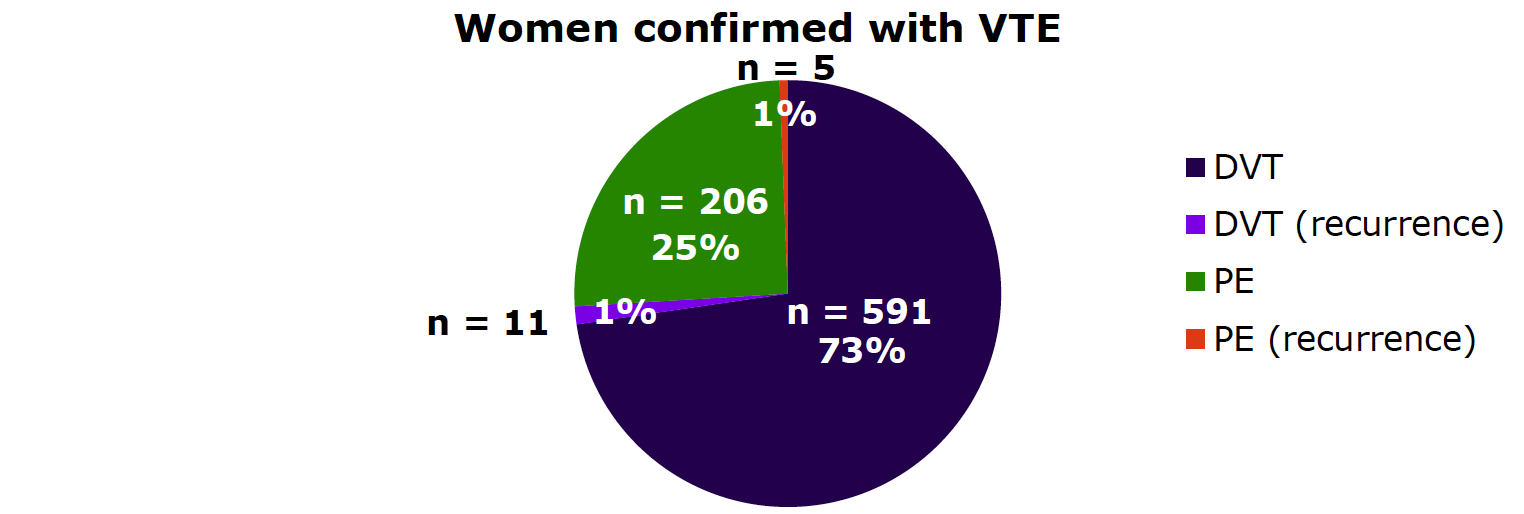Recurrence of venous thromboembolism in patients with recent gestational deep vein thrombosis or pulmonary embolism: Findings from the RIETE Registry
Adapted from Barillari G, et al. European Journal of Internal Medicine. 2016; 32:53-9.

Key Takeaway
- This study provides new insights on VTE recurrence rate in DVT or PE patients during pregnancy and postpartum period
- PE is the most frequent type of VTE occurring in pregnant women with history or recent or previous surgery
- Assessment of thrombotic risk is important for better decision making regarding antithrombotic management
Why This Matters
- 1 in 1000 pregnant women are estimated to have complications due to VTE, which is the leading cause of maternal mortality and morbidity worldwide1-3
- VTE during pregnancy or post-partum is an instigated event such as VTE secondary to surgery, prolonged immobilization, oral contraception, trauma, or hormonal replacement therapy4-8
- There is discrepancy in VTE management in pregnancy among different centers and countries as no clear clinical trials has studied this population
Objective
- To investigate rate of DVT or PE recurrence, major bleeding, or death in women during pregnancy or puerperium
- To identify predictors for VTE recurrence

Study Design
Inclusion criteria: Women confirmed with symptomatic, acute DVT or PE developed during pregnancy or puerperium (up to 42 days after delivery) enrolled in the international, multicenter, prospective RIETE registry
Study period: January 2001 and June 2013
Exclusion criteria: Patient involvement in therapeutic trials with a blind medication or a follow-up of less than three months after the diagnosis
Primary outcome: Recurrent PE (with or without DVT signs), recurrent DVT or major bleeding
Secondary outcome: Fatal VTE and fatal bleeding
Key Results
Of the total 46,770 RIETE registry patients, 607 women were objectively confirmed with VTE during pregnancy or puerperium

- Women with recent surgery showed the incidence of PE more than DVT
- During pregnancy DVT was more common than PE, PE was more common during puerperium
- The most common drug used as initial therapy was LMWH, and then UFH

- The cumulative incidence of VTE recurrence was low at 2 years 3.3% (95% CI, 1.5–5.0)
- Recurrent incidence rate was 2.28 events/100 patients-year
- No significant differences were observed between DVT and PE for initial VTE presentation
- Use of thrombolytics and inferior vena cava filter in initial treatment was associated with increased risk of VTE recurrence

Limitations
RIETE is an observational registry, therefore, results must be interpreted with caution while suggesting changes or adapting any treatment strategies
ABBREVIATIONS
CI, confidence interval; DVT, deep vein thrombosis; LMWH, low molecular-weight heparin; PE, pulmonary embolism; RIETE, Registro Informatizado de la Enfermedad TromboEmbólica; UFH, unfractionated heparin; VKA, vitamin K antagonists; VTE, venous thromboembolism
- Middeldorp S. Thrombosis in women: what are the knowledge gaps in 2013? J Thromb Haemost 2013;11(Suppl. 1):180–91.
- Sultan AA, Tata LJ, West J, et al. Risk factors for first venous thromboembolism around pregnancy: a population-based cohort study from the United Kingdom. Blood 2013;121:3953–61.
- Abdul Sultan A,West J, Tata LJ, Fleming KM, Nelson-Piercy C, Grainge MJ. Risk of first venous thromboembolism in pregnant women in hospital:population-based cohort study from England. BMJ 2013;347:f6099.
- Prandoni P, Noventa F, Ghirarduzzi A, et al. The risk of recurrent venous thromboembolismafter discontinuing anticoagulation in patientswith acute proximal deep vein thrombosis or pulmonary embolism. A prospective cohort study in 1,626 patients. Haematologica 2007;92:199–205.
- Christiansen SC, Cannegieter SC, Koster T, Vandenbroucke JP, Rosendaal FR. Thrombophilia, clinical factors, and recurrent venous thrombotic events. JAMA 2005;293:2352–61.
- Palareti G, Legnani C, Cosmi B, Guazzaloca G, Pancani C, Coccheri S. Risk of venous thromboembolism recurrence: high negative predictive value of Ddimer performed after oral anticoagulation is stopped. Thromb Haemost 2002;87:7–12.
- Prandoni P, Lensing AWA, Prins MH, et al. Residual venous thrombosis as a predictive factor of recurrent venous thromboembolism. Ann Intern Med 2002;137: 955–60.
- Hansson PO, Sörbo J, Eriksson H. Recurrent venous thromboembolism after deep vein thrombosis: incidence and risk factors. Arch Intern Med 2000;160:769–74.
MAT-BH-2300443/V1/June2023